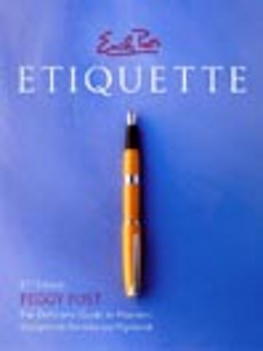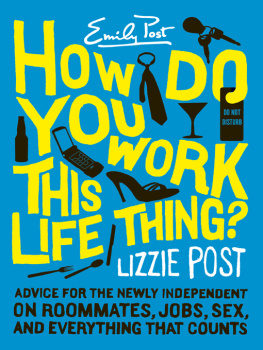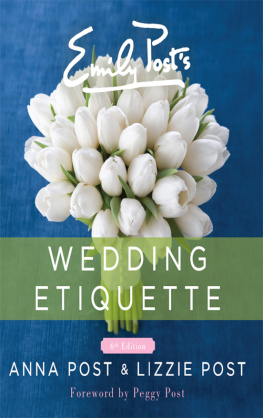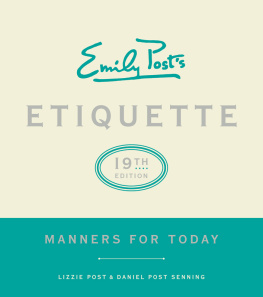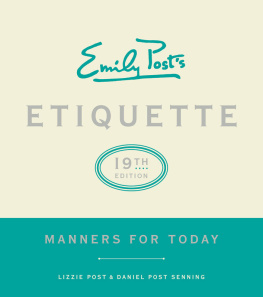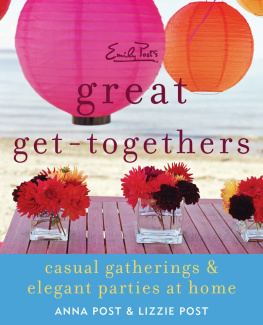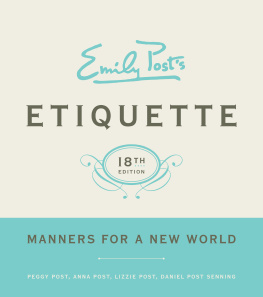for courtesy in todays busy world.
Contents
Part One
Everyday Etiquette
What etiquette is (and isnt) and the pillars on which it is builtGreetings and introductions made easyYour public persona as driver, pedestrian, passenger, and shopperRudeness in its myriad guises and a dozen of todays rudest behaviorsAppropriate clothing choices in an increasingly casual world.
Part Two
Relationships
Newplus tried-and-trueapproaches to datingGetting through a separation or divorce with graceKeeping family life, in its many forms, running smoothlyBuilding stress-free relationships with your neighborsHow to behave when you or someone else is ill, plus courtesies for those with disabilitiesConsideration for people who work in your home.
Part Three
Children and Teens
Getting children off on the right (and mannerly) footGreetings, introductions, and other manners for the youngDressing and grooming choicesHost and guest etiquette, from birthday parties to sleepoversSportsmanship, table manners, and mall mannersDeveloping and honing speaking and writing skills. Teen dating from every angle
Part Four
Communication and Protocol
Proof that the art of letter writing lives onShould you handwrite that note?The return of social cardsWays to become well-spokenConversational blunders to avoidResponding to nosy questionsThe exemplary e-mailerManners in cyberspaceOur love/hate relationship with the cell phoneTitles, forms of address, official protocol, and displaying the flag.
Part Five
Dining and Entertaining
The truth about table mannersEating difficult foods with easeKeeping the fun in eating outSix major faux pas at restaurantsRelaxed dinner parties and cocktail partiesSmart advice for hosts and houseguestsSurviving the social whirl, from casual get-togethers to formal dancesTrouble-free toasting, with sample toasts aplenty.
Part Six
Celebrations and Ceremonies
Dos and donts for baby showers, coming-of-age celebrations, and birthday and anniversary partiesReaffirming marriage vowsThe ABCs of gift givingThe last word on gift registries and regiftingOffering condolences in times of sorrowThe changing funeral serviceOn-line memorialsBehavior in your own house of worship and those of other faiths.
Part Seven
Weddings
Making the engagement officialKeeping wedding plans from spinning out of controlIs a destination wedding a good idea?Invitation styles and timingSix invitation mistakes to avoidGift registries and their alternativesThe personalized ceremony and reception, including same-sex unionsThe good guestMarrying again (and again?)Breaking with tradition.
Part Eight
You and Your Job
Getting along with coworkers and supervisorsDealing with workplace dilemmasCubicle etiquetteKeeping meetings running smoothlyBusiness meals, office parties, and other entertainmentsRelationships between the sexes.
Part Nine
Travel and Leisure
The new airplane etiquetteRules of the roadSmooth sailing on cruisesAdjusting your cultural lens overseasYour tipping questions answeredThe ubiquitous tip jarAudience etiquetteHiking, camping, and boating dos and dontsgood sportsmanship for tennis players and golfers, skiers and skatersStaying on your toes at fitness centers and athletic events.
So many people have been generous with their time and knowledge as theyve helped me with the creation of this book. It is with deep appreciation that I would like to acknowledge the following for their contributions:
Martha Hailey and Fred DuBose for their invaluable insights, creative talents, and hard work throughout this entire projectthey have been my right and left arms, from start to finish!
Cindy Post Senning, Elizabeth Howell, and Peter Post at The Emily Post Institute, and Katherine Cowles, our agent, for their steady support, ideas, and assistance.
Toni Sciarra, Greg Chaput, Diane Aronson, and Nick Darrell of HarperCollins, whose editing skills have been essential to the completion of the book, and Bill Ruoto, Leah Carlson-Stanisic, and Karen Lumley for their design and production expertise. Stephen Hanselman, Mary Ellen Curley, and the entire HarperCollins team for their constant support and creative ideas.
Alexis Flippin, Kathy Schwarz, Lynn Ferrari, and Anna Post, who have been a formidable research team; their efforts have helped me to assure the accuracy and completeness of the book.
Manners and customs vary from region to region and culture to culture. The following people were gracious in sharing their knowledge of various regions, cultures, and religions: Himi Akdag, Dr. Parveen Ali, Dr. Shaukat Ali, Robert Barnett, Sister Janet Baxindale, Andrew Benko, Hilton Caston, Mustafa Gundogan, Naomi Krauss, Father Nektarios Morrow, Father James G. Moskovites, Theo Nicolakis, Harold and Ilana Rabinowitz, Thomas A. Ranieri, Wanda Vasquez, Ersin Yazicioglu, and Erhan Yildirim.
Etiquette covers so many aspects of our lives and relationships that I have found myself drawing information from a myriad of people who had important contributions to the advice offered herein: Kimi Abernathy, Richard Bailey, Sarah Buchwald, Ashley Dixon Burns, Harriett Temple Caldwell, Josette Caruso, Evelyn Christman, Barbara and Allan Converse, Diana Dixon, Polly DuBose, Hope Egan, Royce Flippin, Steve and Cathi Fowler, Sue Beasley Fryer, Vera Gibbons, Joseph Gonzalez, Allegra Holch, Peter Hopkins, David Kornacker, Eileen Leong, Deborah Leslie, Amy Lin, Kevin Mack, Kalinda Matthews, Kathy Maycen, David Miner, Bob Moore, Karen Nelson, Megan Newman, John Parker, Angela Ponce, Casey Post, Teresa Reagan, Matthew Reagor, Kelly Regan, Barbara Richert, Eric Rutz, David Shields, Cindi Smith-Walters, Ph.D., Fay Spano, Evan Spingarn, James F. Sporrer, Kate Stark, Mark Teague, Ginger Van Wagenen, and David Walkinshaw.
And, finally but not least, I thank my family, who has always supported me in more ways than I can express: My father, Ferd Grayson; my parents-in-law, Bill and Libby Post; and the person who has always encouraged me and patiently understood my long hours at the computer and on the telephone while working on this book, my husband, Allen Post.
What a pleasure it is to bring you an all-new, completely rewritten edition of a book that has been a staple of American life for eighty-two years! Times are changing so rapidly its a challenge for most of us to keep up, but Im happy to assure you that helping people adapt has been a mainstay of the Emily Post philosophy from the beginning.
Emily knew when she wrote Etiquette: The Blue Book of Social Usage (1922) that it was time for a reappraisal of the Victorian rules of etiquette. As a result, her revolutionary book discounted manners as rigid rules, tied them instead to ethics and values, and saw them as belonging to people from all walks of life. She also stressed that manners should be fluid, adaptable not only to the times but to the situation at hand. The same is true today. Considering the stuffiness of the etiquette books that had gone before, my great-grandmother-in-law would probably have told her readers to lighten up! had the phrase been around in her day.

